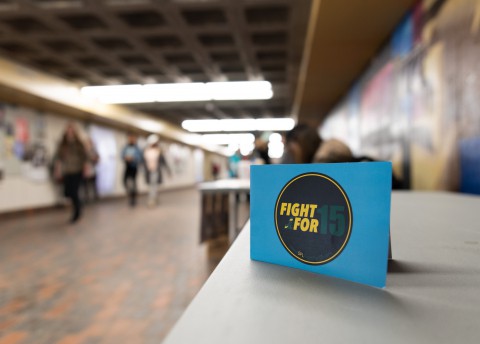Two students have taken to the Arts Tunnel to combat the current wage levels in Saskatchewan. Joining the Fight for 15 movement, the students argue that the current provincial minimum wage is unlivable and should be increased to $15 per hour.
Deena Kapacila and Aidan Murphy, both fourth-year political studies students, are organizing the efforts on campus. In addition to tabling in the Arts Tunnel, the pair is working to raise awareness by sending postcards to figures like Don Morgan, the Saskatchewan Minister of Labour Relations and Workplace Safety, who is responsible for increases to the provincial minimum wage.

These postcards provide a brief summary of the sender’s concerns and aspirations for future changes.
Murphy says that the current minimum wage does not address the economic reality for many Saskatchewanians.
“A $15 minimum wage will bring a lot of people out of what is a poverty wage, at $11.06 currently, in Saskatchewan,” Murphy said. “That wage simply isn’t a livable wage for people. They can’t afford things like rent, food [and] housing.”
For Murphy, the use of the term “poverty wage” stems from Charles Plante, a sessional instructor at the University of Saskatchewan, who calculated that Saskatoon’s hourly living wage was $16.19 per hour at a rate of 35 work hours per week.
While the push for a $15 minimum wage does not quite reach Plante’s suggested living wage, Murphy believes that it will help spark the conversation around the topic and work to promote future changes that will eventually meet this goal.
“Raising the minimum wage to be a lot closer to a livable wage … helps the whole province,” Murphy said. “What we have to do then is fight to make sure that everyone knows about this issue … [so] that we can give voice to those 20 per cent of the workers who are making under $15 an hour and [are] just simply not able to afford rent, food and clothes.”
While the push for an increased minimum wage has garnered passionate support, concerns have also been raised whenever such propositions gain traction. When asked about such criticisms, Joel Bruneau, the U of S department head of economics, says that “the people who manage to keep their jobs would be better off.”
However, Bruneau also cautions that, if an increase were too high or implemented too suddenly, it would likely drive businesses to reduce the number of available positions, decrease benefits and move “towards increased automation” in order to mitigate losses in revenue.
“So long as wages don’t rise too high, job loss should be quite low,” Bruneau said. “A slow increase is better for minimum wage as businesses are more likely to take the hit better.”
Bruneau suggests that supporters of the movement “go for $15 but also push for things like job training and initiatives for business to hire young people,” those who he says are statistically more likely to be working in minimum-wage positions.
Bruneau says that it is important for advocates of raising the provincial minimum wage to $15 to consider additional measures to help the people who might lose their jobs as a result of the wage increase.
“It’s wishful thinking that the increase in wages will grow the economy and create enough jobs to replace those that we’d lose,” Bruneau said. “An
increase of the minimum wage will not solve all economic problems, like wage inequality. It’s just one small tool that could be helpful.”
—
Rychel Smith
Photo: Riley Deacon / Photo Editor